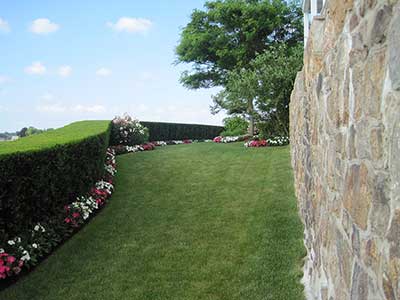 Lawn care does not have to be a full-time job. Like a house, it all starts with a solid foundation. It is only logical, but often overlooked. Understanding the concepts below will help analyze and build a plan for easier lawn care over time that can result in a great-looking, low-maintenance lawn.
Lawn care does not have to be a full-time job. Like a house, it all starts with a solid foundation. It is only logical, but often overlooked. Understanding the concepts below will help analyze and build a plan for easier lawn care over time that can result in a great-looking, low-maintenance lawn.
There are several ways a healthy plant can be grown. They can be grown in good soil without much effort or they can be grown in bad soil with much more effort and cost. Even in poor soil, if plants are fed enough water and nutrients to meet their needs and are monitored closely for inevitable problems, they can do fine. It has been proven that plants can be grown without soil via a hydroponic system. These are much higher-maintenance approaches compared to cultivating a lawn or planting with a deep enough layer of quality, nutrient-rich topsoil. Nature takes care of the balance of what is needed (other than during a drought), so ongoing lawn care is much easier.
Lawn grasses are some of the most resilient plants on earth. Few plants can have their tops cut off repeatedly and survive. They can have their roots cut off, be moved to horrible soil conditions and survive. If it is too hot, too cold or too dry, they go dormant and survive. They bounce back from a variety of ball sports that damage the top and uproot the bottom. They do this all while producing oxygen, reducing runoff and dust, cooling the surroundings and looking pretty.
Most lawn problems start because the grass plants can't grow well due to poor soil. A lawn with poor soil will require more work to keep it growing and healthy, or it will be sparse and full of weeds.
Qualities of High-Quality Topsoil
 First, a good soil is alive. It is filled with worms, insects, microscopic animals, bacteria, fungi and other organisms. Plant roots are healthier when they are surrounded by organisms that are often killed when the fertilizers, herbicides and insecticides are applied. Applying fertilizers that are slow release and based on plant materials, rather than chemical salts, will be less likely to damage the soil. Applying a thin layer of compost to a lawn each Spring will feed numerous organisms that, in turn, will supply the grass plants with the nutrients they need.
First, a good soil is alive. It is filled with worms, insects, microscopic animals, bacteria, fungi and other organisms. Plant roots are healthier when they are surrounded by organisms that are often killed when the fertilizers, herbicides and insecticides are applied. Applying fertilizers that are slow release and based on plant materials, rather than chemical salts, will be less likely to damage the soil. Applying a thin layer of compost to a lawn each Spring will feed numerous organisms that, in turn, will supply the grass plants with the nutrients they need.
Second, to meet the nutrient and moisture needs of a plant, the soil must be deep enough so the roots can grow to their maximum potential. Healthy, low-maintenance lawn grasses need a minimum of six inches of good topsoil. Very often, lawns survive on less than that amount, but it takes more maintenance by the homeowner to keep it healthy. A thin cover of lawn grasses can be kept on just an inch or two of soil, but don't expect it to handle much wear and tear from activities. If other plant roots share the soil, they compete for water and nutrients with the lawn grasses. Deeper topsoil of higher quality holds more water as a buffer for dry times.
The last thing lawn soil must have is good drainage. Grass roots need air and water in the soil. If the pore spaces are filled with water, the roots will drown. If the soil is compacted, there are not enough pore spaces to have air or water and the roots will not be able to grow in it. Sandy soil can have too many pores and so it won't store moisture, greatly increasing the need for more watering and lawn care in general. Adding composted organic matter will benefit any soil type and help cure all of the pore space problems.
To Grow a Good-Looking Lawn
Start with quality topsoil at the full depth of six inches, which is optimum. If your topsoil is thin or of poor quality, top-dress with high quality topsoil and a fine layer of compost to build it up over time.
Plant the right grass for your climate and sunlight conditions. Over-seed with new grass every year or two.
Use the right tools to mow properly. Leave all clippings that are not diseased. Keep the grass plant as tall as possible. A bigger top will allow for a bigger root system.
Water infrequently, but deeply. Deep watering saturates more soil, reducing the need for care. A deeper, wet soil is like a bigger sponge that accepts a bigger root system.
Quality topsoil will reduce your lawn care requirements, Call The Dirt Guy at 860-303-0500